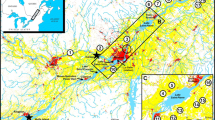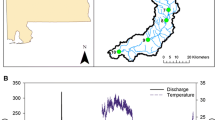Abstract
The concentrations and transport of carbon, nitrogen, and phosphorus were studied in the Apure River, Venezuela, over a period of 21 months. The drainage basin, which is in western Venezuela, encompasses 167,000 kM2, most of which has low relief and supports tropical savanna vegetation. Average runoff for the period of study was 361 mm/year. Discharge-weighted mean concentrations were 188 ug/l for total P, 957 ug/l for total N, and 9.8 mg/l for organic C. Annual transport was 0.68 kg· ha-1· year-1 for total P, 3.45 kg · ha-1· year-1 for total N, and 35.4 kg · ha-1 · year-1 for organic C. Particulate matter accounted for 68% of P, 54% of N, and 37% of C transport. The yield of carbon from the Apure watershed agrees well with empirical predictions, based mostly on the temperate zone, for watersheds of similar size and water yield.
Seasonal patterns in chemistry are tied strongly to the hydrologic cycle. When the wet season begins, rising water flushes organic matter from side channels and produces a sharp increase in particulate C and N. Particulate P, which is associated more with mineral material, also increases during rising water. All dissolved constituents except inorganic C also increase over the rising-water phase. As the river inundates the floodplain, the concentration of nitrate declines, whereas the concentrations of dissolved organic C and N continue to rise. At high water the floodplain appears to store sediments that are later remobilized. During low water, all fractions except dissolved inorganic C tend to be at minimum concentration.
Soluble reactive P, total dissolved P, dissolved inorganic C, and dissolved organic C were successfully modelled as hyperbolic functions of discharge. No significant relationships were found between concentration and discharge for any particulate fraction because the flushing and storage mechanisms affecting these fractions occurred within specific hydrologic phases, rather than as a smooth function of discharge. No significant relationships were found for any nitrogen fraction. For nitrate, and thus for total dissolved N, of which nitrate is a major component, poor conformance to standard models is explained by association of key mechanisms (e.g. uptake) with specific hydrologic phases. Particulate components and nitrate in this sense violate the continuity assumptions implicit in the standard models.
Similar content being viewed by others
References
Bendschneider, K. & R.J. Robinson (1952) A new spectrophotometric method for the determination of nitrate in sea water. J. Mar. Res. 11: 87–96
Cuevas, E. & E. Medina (1986) Nutrient dynamics within amazonian forest ecosystems. I. Nutrient flux in the litter fall and efficiency of nutrient utilization. Oecol. 68: 466–472
Ewel, J.J., A. Madriz & J.A. Tosi, Jr. (1976) Zonas de Vida de Venezuela. Sucre, Caracas
Grasshoff, K. 1976. Methods of Sea Water Analysis. Verlag Chemie, Weinheim
Hall, F.R. (1970) Dissolved solids-discharge relationships. 1. Mixing Models. Water Resources Res. 6: 845–850
Hamilton, S.K. & W.M. Lewis, Jr. (1987) Chemistry and nutrient mass balance of a floodplain lake on the Orinoco River floodplain, Venezuela. Limnol. Oceanogr. 32: 1277–1290
Hase, H. & H. Folster (1982) Bioelement inventory of a tropical (semi-) evergreen seasonal forest on eutrophic alluvial soils, western Llanos, Venezuela. Acta Oecol./Oecol. Plant. 3: 331–346
Hedges, J.I., W.A. Clark, P.D. Quay, J.E. Richey, A.H. Devol & U. de M. Santos (1986) Compositions and fluxes of particulate organic material in the Amazon River. Limnol. Oceanogr. 31: 717–738
Howard-Williams, C. & W.J. Junk (1977) The chemical composition of Central Amazonian aquatic macrophytes with special reference to their role in the ecosystem. Arch. Hydrobiol. 79: 446–464
Johnson, N.M., G.E. Likens, F.H. Bormann, D.W. Fisher & R.S. Pierce (1969) A working model for the variation in streamwater chemistry at the Hubbard Brook Experimental Forest, New Hampshire. Water Resources Res. 5: 1353–1363
Jordan, C.F. (1985) Nutrient Cycling in Tropical Forest Ecosystems. Wiley, New York
Lesack, L.R., R.E. Hecky & J.M. Melack (1984) Transport of carbon, nitrogen, phosphorus, and major solutes in the Gambia River, West Africa. Limnol. Oceanogr. 29: 816–830
Levine, S.N. & D.W. Schindler (1980) Radiochemical analysis of orthophosphate concentration and seasonal changes in the flux of orthophosphate to seston in Canadian Shield lakes. Can. J. Fish. Aquat. Sci. 37: 479–487
Lewis, W.M., Jr. (1986) Nitrogen and phosphorus runoff losses from a nutrient-poor tropical moist forest. Ecol. 67: 1275–1282
Lewis, W.M., Jr. (1987) Tropical Limnology. Ann. Rev. Ecol. Syst. 18: 159–184
Lewis, W.M. Jr., J.F. Saunders III, F.H. Weibezahn, & S.N. Levine (1986) Organic carbon in the Caura River, Venezuela. Limnol. Oceanogr. 31: 653–656
Likens, G.E., F.H. Bormann & N.M. Johnson (1981) Interactions between major biogeochemical cycles in terrestrial ecosystems. In: G.E. Likens (Ed) Some Perspectives of the Major Biogeochemical Cycles, Scope pp 93–112. Scope 17. Wiley, New York
MARNR. (1983) Venezuela en Mapas. Ministerio del Ambiente y de los Recursos Naturales Renovables. Caracas
Martins, O. (1982) Geochemistry of the Niger River. In: E.T. Degens (Ed) Transport of Carbon and Minerals in Major World Rivers. Part I. Mitt. Geol.-Palaont. Inst. Univ. Hamburg, SCOPE/UNEP Sonderbd. 52: 397–418
Meade, R.H., C.F. Nordin, Jr., D. Perez Hernandez, A. Mejia & J.M. Perez Godoy (1983) Sediment and water discharge in Rio Orinoco, Venezuela and Colombia. In: Proc. Second Internat. Symposium on River Sedimentation, 11–16 October, 1983, Nanjing, China (pp. 1134–1144). Water Resources and Electric Power Press, Beijing
Meybeck, M. (1982) Carbon, nitrogen, and phosphorus transport by world rivers. Amer. Jour. Sci. 282: 401–450
Murphy, J. & J.P. Riley (1962) A modified single solution method for the determination of phosphate in natural waters. Anal. Chim. Acta 27: 31–36
Nordin, C. F., Jr. & J.V. Skinner (1977) Sediment sampling equipment for deep fast currents. Proc. Internat. Assoc. Hydraul. Res. 6: 606–609
Nordin, C.F., Jr., C.C. Cranston & A. Mejia. (1983) New technology for measuring water and suspended-sediment discharge of large rivers. In: Proc. Second Internat. Symposium on River Sedimentation, 11–16 October, 1983, Nanjing, China (pp. 1145–1158). Water Resources and Electric Power Press, Beijing
Ramia, M. (1967) Tipos de sabanas en los Llanos de Venezuela. Bol. Soc. Venezolana Cien. Nat. 112: 262–288
Redfield, A.C. (1958) The biological control of chemical factors in the environment. Am. Scientist 46: 205–221
Richey, J.E., E. Salati & V. Dos Santos (1985) Biochemistry of the Amazon River: an update. In: E.T. Degens & S. Kempe (Eds), Transport of Carbon and Minerals in Major World Rivers. Part 3. Mitt. Geol. Palaont. Inst. Univ. Hamburg, SCOPE/UNEP Sonderbd. 58: 245–257
Rigler, F.H. (1968) Further observations inconsistent with the hypothesis that the molybdenum blue method measures orthophosphate in lake water. Limnol. Oceanogr. 13: 7–13
San Jose, J.J., R. Montes, J. Garcia-Miragaya & B.E. Orihuela (1985) Bioproduction of trachypogon savannas in a latitudinal cross-section of the Orinoco Llanos, Venezuela. Acta Oecol./Oecol. Gener. 67: 25–43
Schlesinger, W.H. & J.M. Melack (1981) Transport of organic carbon in world's rivers. Tellus 33: 172–187
Sheldon, R.W. (1972) Size separations of marine seston by membrane and glass-fiber filters. Limnol. Oceanogr. 17: 494–498
Sokal, R.R. & R.J. Rohlf (1981) Biometry, second ed. Freeman, San Francisco
Solorzano, L. & J. Sharp (1980a) Determination of total dissolved phosphorus and particulate phosphorus in natural waters. Limnol. Oceanogr. 25: 754–758
Solorzano, L. & J. Sharp (1980b) Determination of total dissolved nitrogen in natural waters. Limnol. Oceanogr. 25: 751–754
Stevens, H.H., Jr., G.A. Lutz & D.W. Hubbell (1980) Collapsible-bag suspended-sediment sampler. American Society of Civil Engineers Proceedings 106: 611–616
Stumm, W. & J.J. Morgan (1981) Aquatic Chemistry, second ed. Wiley, New York
Welcomme, R. (1979) Fisheries Ecology of Floodplain Rivers. Longman, London
Wood, E.D., F.A.J. Armstrong & F.A. Richards (1967) Determination of nitrate in sea water by cadmium copper reduction to nitrite. J. Mar. Biol. Assoc. UK 47: 23–31
Zinck, A. (1977) Rios de Venezuela. Cuadernos Lagoven. Caracas
Author information
Authors and Affiliations
Rights and permissions
About this article
Cite this article
Saunders, J.F., Lewis, W.M. Transport of phosphorus, nitrogen, and carbon by the Apure River, Venezuela. Biogeochemistry 5, 323–342 (1988). https://doi.org/10.1007/BF02180071
Issue Date:
DOI: https://doi.org/10.1007/BF02180071




